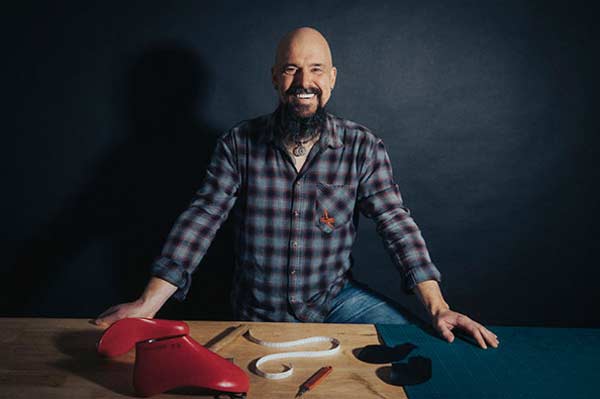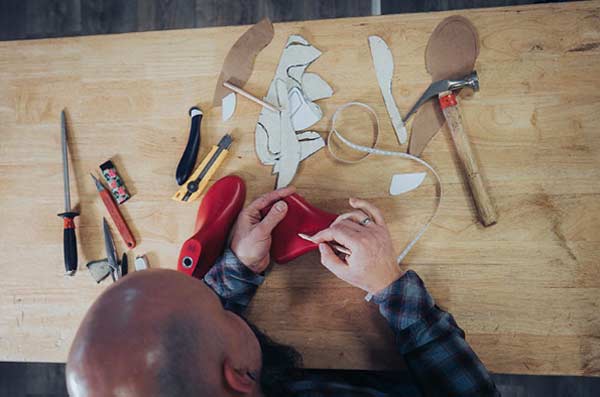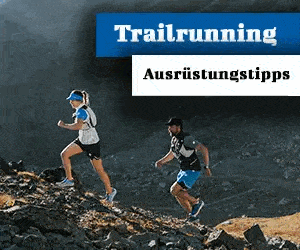To keep your feet on the wall, you need climbing shoes with a solid sole. And there's a lot more to it than meets the eye. We took a closer look at the black material and show you how shoe manufacturers come up with the perfect rubber compound.
A contribution by Fabian Reichle - Bächli Bergsport
climbing Shoes seem simple at first glance: upper material, closure system, smooth sole. A closer look reveals ergonomic properties such as asymmetry, pre-tension and downturn, which influence the fit. And if you take a closer look at the footwear, you will be confronted with seemingly cryptic sole descriptions.
Well-known manufacturers advertise with XS-Grip 2, Trax SAS, RH, Edge or FriXion. At the latest now, laypersons should have lost track of things. Is it all just marketing? Partly yes. But the ominous titles have their justification, because each rubber compound, which obviously has a technical name, has specific properties that distinguish it from others.
Chemical processes and tinkering
In order to understand what defines the black coating on climbing shoes, we must first clarify some terms. In this regard, it is important to understand what rubber actually is. A distinction is made between natural and industrial rubber. The former is a plant sap. The latter belongs to the group of plastics that are dimensionally stable but elastically deformable - so-called elastomers.

Rubber is made using a chemical process called vulcanization. Industrial rubber is 97 percent petroleum based. The mechanical properties are defined with the remaining three percent by means of chemical additives: stickiness, abrasion, elasticity and so on. And another substance is found in rubber: carbon black, which is added to reinforce it. Hence the pitch-black color of the material.
And another finding: Industrial rubber is definitely not a sustainable product. The REACH standard, which regulates the chemical composition for industrial processes, serves as the European basis for the mixture in the rubber.
A distinction is made between natural and industrial rubber. The former is a plant sap. The latter belongs to the group of plastics that are dimensionally stable but elastically deformable - so-called elastomers.
All in all, a margin of three percent and chemical nuances define friction, abrasion, density and hardness of the climbing shoe sole and thus also its description. What sounds like little is nevertheless a lengthy process.
Martin Waibel, Head of Climbing Shoe Development at Red Chili, knows this very well and describes it using a current model of climbing shoe: "The design was ready in a month, but the perfect rubber compound took three years of work."
A question of use
It starts with the fact that the area of use of the climbing shoe has to be considered. According to Waibel, a rental shoe for climbing gyms is provided with durable rubber. A high-end product, on the other hand, needs more stickiness for a fuller hold. This is associated with higher abrasion, which means that wear and tear occurs more quickly. The crux is finding the perfect balance.

The area of use plays an important role, especially with high-quality climbing shoes. In order to be able to stand on narrow granite ledges, the climbing shoe needs a hard sole with good edge hold. For efficient toe hooks, on the other hand, a toe cap made of softer, more adhesive rubber is an advantage.
For climbers, it is ultimately crucial that they bring their performance to the wall. The rubber compound should support you in this. It shouldn't really make a difference whether it has this name or that. Actually. There are reasons why the soles of climbing shoes are made from an explicit rubber compound.
Brand psychology
Vibram, for example, offers their XS Grip 2 product for all manufacturers. Vibram Edge and XS 1, on the other hand, are only available for Scarpa and La Sportiva. In addition, there are producers like Unparallel who use in-house mixes and advertise them accordingly.
There is also a psychological factor involved in the soling. This is particularly noticeable when rubber compounds from the traditional Italian company Vibram - whose name is derived from Vitale Bramani, the company founder - are used.
"If shoes with a Vibram stamp quickly rub off on the rock, customers are more likely to accept it than those without."
Martin Waibel, head of climbing shoe development at Red Chili
The yellow logo is so firmly established in the minds of mountaineers as a seal of quality that shoes with it are automatically perceived as better, even if other rubber compounds are equivalent. "If shoes with a Vibram stamp quickly rub off on the rock, customers are more likely to accept it than shoes without," says Waibel.
Ultimately, it is important to judge a climbing shoe according to the criteria of its intended use. Anyone who has found the optimal fit in a model is well advised to take a close look at the rubber compound. Every technical, marketing-driven term can be deciphered. With the background knowledge about stickiness, abrasion or hardness, what is in and of itself a highly complex topic will hopefully become understandable.
That might interest you
- Sunglasses for mountain sports: More than just protection for the eyes
- Climbing and bouldering brushes from Faza Brushes: Unique, handmade and natural
- These 10 apps support you in mountaineering
About Bächli mountain sports
Bächli mountain sports is the leading Swiss specialist shop for climbing, mountaineering, expeditions, hiking, ski touring and snowshoeing. Currently offering 11 locations in Switzerland Bächli mountain sports its customers expert advice and high quality service. LACRUX publishes in collaboration with Bächli mountain sports Articles on the topics of climbing and bouldering.
+ + +
Credits: Cover picture


